|
|
 |
|
Cyclopoida ( Order ) |
|
|
|
Corycaeidae ( Family ) |
|
|
|
Corycaeus ( Genus ) |
|
|
|
Ditrichocorycaeus ( Sub-Genus ) |
|
|
| |
Corycaeus (Ditrichocorycaeus) minimus F. Dahl, 1894 (F,M) | |
| | | | | | | Syn.: | Ditrichocorycaeus minimus : Klevenhusen, 1933 a (p.92, Rem.); Boxshall & Halsey, 2004 (p.495); Vives & Shmeleva, 2010 (p.218, figs.F,M, Rem.);
Ditrichocorycaeus minimus indicus : Vidjak & Bojanic, 2008 (p.233, Redescr. F, M, figs.F,M, Rem); Vidjak & Bojanic, 2009 (p.433, Table II, IV, V) | | | | Ref.: | | | &F. Dahl, 1894 (p.71); M. Dahl, 1912 (p.53, figs.F,M); Farran, 1936 a (p.137, Rem.); Wilson, 1942 a (p.181, fig.F); Björnberg & al., 1981 (p.676, figs.F,M); Lakkis Zeidane, 1987 (p.22, Rem.); Boxshall, 1998 (p.223); | 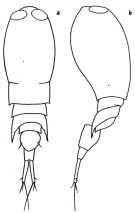 issued from : G.P. Farran in Great Barrier Reef Expedition 1928-29. Scientific Reports, V, No.3. Copepoda. 1936 [p.136, Fig.29]. Female: a, habitus (dorsal); b, idem (lateral left side). Nota: These specimens come very near to Dahl's description of C. minimus indicus/; they differ in the slightly longer furca, twice as long as the anal segment and 7.5 to 8 times as long as wide. As compared with Dahl's figure, the genital segment is broader and more globular in dorsal view. Klevenhusen (1933) has described, from the Atlantic, a form with a ventral hook on the genital segment, in our specimens there is a minute rudimentary hook.
|
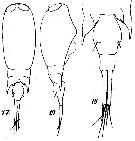 issued from : M. Dahl in Ergebnisse der Plankton-Expedition der Humboldt-Stiftung. Bd II, G. f1. I. Die Corycaeinen 1912. [Taf.VIII, Figs.17, 18, 19]. Female: 17, habitus (dorsal); 18, urosome (dorsal); 19, habitus (lateral right side).
|
 issued from : M. Dahl in Ergebnisse der Plankton-Expedition der Humboldt-Stiftung. Bd II, G. f1. I. Die Corycaeinen 1912. [Taf.VIII, Figs.22, 23, 24]. Female: 22, A2; 23, P2 (distal part of exopod 3), 24, P4.
|
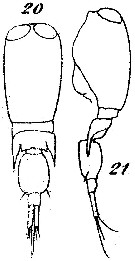 issued from : M. Dahl in Ergebnisse der Plankton-Expedition der Humboldt-Stiftung. Bd II, G. f1. I. Die Corycaeinen 1912. [Taf.VIII, Figs.20, 21]. Male: 20, habitus (dorsal); 21, idem (lateral left side).
|
 issued from : M. Dahl in Ergebnisse der Plankton-Expedition der Humboldt-Stiftung. Bd II, G. f1. I. Die Corycaeinen 1912. [Taf.IX, Fig.1, 2]. As Corycaeus (Dirichocorycaeus) minimus indicus.
Female: 1, habitus (dorsal); 2, idem (lateral left side).
|
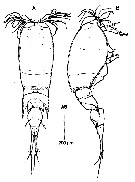 issued from : O. Vidjak & N. Bojanic in J. Plankton Res., 2008, 30 (3). [p.234, Fig.1]. As Ditrichocorycaeus minimus indicus. Female (from middle Adriatic Sea): A-B, habitus (dorsal and lateral, respectively). Nota: Genital somite 1.2 times longer than wide. Minute hook-like projection arising from the anterior ventral margin evident in lateral view.
|
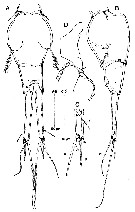 issued from : O. Vidjak & N. Bojanic in J. Plankton Res., 2008, 30 (3). [p.235, Fig.2]. As Ditrichocorycaeus minimus indicus. Female: A, urosome (dorsal); B, same (lateral); C, caudal ramus (ventral; dorsal seta VII omitted); D, vestigial inner coxal seta on P3. Nota: Genital area positioned dorsolaterally, genital apertures paire, hidden behind opercula; each operculum armed with one long plumose seta. Eggs carried in a single egg sac. Caudal rami cylindrical, 1.1 times shorter than genital somite, 1.7 times longer than anal somite and about 7 times longer than wide at base
|
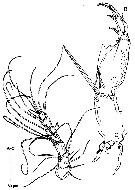 issued from : O. Vidjak & N. Bojanic in J. Plankton Res., 2008, 30 (3). [p.235, Fig.3, A-C]. As Ditrichocorycaeus minimus indicus. Female: A, A1 (aesthetascs arrowed); B, A2 (ventral); C, antennal coxobasis (dorsal). Nota: A2 uniramous, 4-segmented, with coxa and basis fused and bearing 3 endopodal segments; Coxobasis with 1 powerful bipinnate seta arising from the inner distal margin and reaching over the distal margin of the next segment, 1st endopodal segment bearing 1 stout heavily plumose seta above the proximal margin which is 2.7 times shorter than the coxobasal seta, inner distal margin of the segment ends in 2 powerful teeth, outer lateral margin and surface randomly ornamented with short teeth; 2nd endopodal segment short bearing 3 elements: curved spine arising from the outer margin, small stout spine located near its base and curved spine arising from the inner margin; 3rd endopodal segment cylindrical, armed with 5 elements: 1 stout terminal claw, 2 vestigial setae fused with its basis, shorter claw arising from the inner margin of the segment and 1 thin seta with the filamentous ending.
|
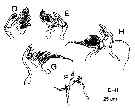 issued from : O. Vidjak & N. Bojanic in J. Plankton Res., 2008, 30 (3). [p.235, Fig.3, D-H]. As Ditrichocorycaeus minimus indicus. Female: D, Md (ventral view); E, Md (dorsal view); F, Mx1; G, Mx2 (dorsal view); H, Mx2 (ventral view). Nota: Md comprising gnathobase with 1 spine and 1 blade, separated by the bifidose process; Spine robust, bicuspid, with spiniform processes on both dorsal and ventral sides; blade pectinate on top, surrounded by a row of spinules around the base.Mx1 reduced, bearing 4 articulated spinous elements. Mx2 2-segmented, with large unarmed syncoxa and small basis ending in curved claw distally and bearing additional spinous element.
|
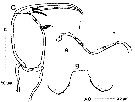 issued from : O. Vidjak & N. Bojanic in J. Plankton Res., 2008, 30 (3). [p.236, Fig.4]. As Ditrichocorycaeus minimus indicus. Female: A, rostral area; B, labrum; C, Mxp. Nota: Labrum bilobated, distal margin with numerous teeth. Mxp 3-segmented; syncoxa unarmed; basis oval, with 2 elements arising from the inner palmar margin: short pinnate seta and tiny transparent seta near its base; endopod drawn out and incorporated into strong claw, bearing 2 pinnate setae above the proximal margin.
|
 issued from : O. Vidjak & N. Bojanic in J. Plankton Res., 2008, 30 (3). [p.236, Fig.5]. As Ditrichocorycaeus minimus indicus. Female: A, P1; B, P2; C, P3 (vestigial inner coxal seta arrowed); D, P4; E, intercoxal sclerite of P4. (setulation on most exopodal and endopodal setae omitted)
|
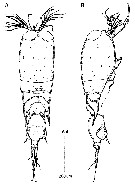 issued from : O. Vidjak & N. Bojanic in J. Plankton Res., 2008, 30 (3). [p.237, Fig.6]. As Ditrichocorycaeus minimus indicus. Male: A-B, habitus (dorsal and lateral, respectively).
|
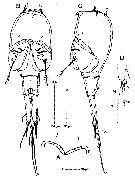 issued from : O. Vidjak & N. Bojanic in J. Plankton Res., 2008, 30 (3). [p.237, Fig.7]. As Ditrichocorycaeus minimus indicus. Male: A, rostral area; B-C, urosome (ventral) and lateral, respectively); D, caudal ramus (ventral; dorsal seta VII omitted). Nota: Genital somite with ventral hook arising from the anterior ventral margin (prominent in lateral view)); distal margin with array of fine teeth ventrally, dorsal edge flat; genital area positioned midventrally, genital openings paired, covered with flaps (derived from six legs), each flap medially bearing a long sparsely plumose seta with bidentate cover at the base, medial surface above the setae ornamented with several rows of unequal teeth. Anal somite squarish, equal in length and width, with large anal opening dorsally, 3.7 times shorter than the genital somite; distal margin ends with coarse teeth ventrally and dorsally; both surfaves unornamented, with several large tubular pores. Caudal rami parallel, cylindrical, 1.7 times longer than anal somite and about 5 times longer than wide at the base.
|
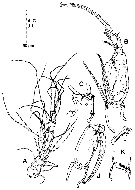 issued from : O. Vidjak & N. Bojanic in J. Plankton Res., 2008, 30 (3). [p.238, Fig.8, A-C, J-L)]. As Ditrichocorycaeus minimus indicus. Male: A, A1 (ventral); B, A2 (ventral); C, antennal coxobasis (dorsal); J, Mxp (ventral); K, syncoxa of Mxp (dorsal); L, detail of Mxp terminal claw.
|
 issued from : O. Vidjak & N. Bojanic in J. Plankton Res., 2008, 30 (3). [p.238, Fig.8, D-I]. As Ditrichocorycaeus minimus indicus. Male: D, labrum; E, Md (dorsal view); F, Md (ventral view); G, Mx1; H, Mx2 (dorsal view); I, Mx2 (ventral view).
|
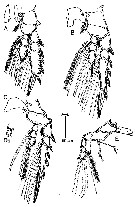 issued from : O. Vidjak & N. Bojanic in J. Plankton Res., 2008, 30 (3). [p.239, Fig.9]. As Ditrichocorycaeus minimus indicus. Male: A, P1; B, P2; C, P3 (vestigialinner coxal seta arrowed); D, detail of the left P3 terminal endopodal segment; E, P4. (setation on most exopodal and endopodal setae omitted).
|
 [B & H] Female: Caudal rami long, as measured along ventral margin in lateral view, either at least twice as long as anal somite or at least 67 % as long as genital double-somite. Anal somite measured dorsally almost longer than wide. Male: Caudal rami long, as measured along ventral margin in lateral view, either at least twice as long as anal somite or at least 67 % as long as genital double-somite. [V & S] Female: Genital segment plus anal segment much longer than caudal rami. Spine of basipodite 1 of A2 2 times longer than spine of basipodite 2. Basipodite 2 of A2 with 2 teeth curved, ending in point on the inner distal margin. male: Posterior points of thoracic segment 3 longer than 1/3 genital segment. Genital segment with minute hook downward (in lateral view).Basipodite 2 of A2 with 2 ordinary, normal, teeth on the inner distal margin. Distal hook shorter than half basipodite 2.
| | | | | Compl. Ref.: | | | Sewell, 1948 (p.420, 431: Rem., 461); Deevey, 1971 (p.224); Vives & al., 1975 (p.58, tab.II, III, Rem.); Kovalev & Shmeleva, 1982 (p.86); Benedetti & al., 2016 (p.159, Table I, fig.1, functional characters) | | | | NZ: | 7 | | |
|
Distribution map of Corycaeus (Ditrichocorycaeus) minimus by geographical zones
|
| | | | | | | | | | Loc: | | | SE Atlant., Brazil, off S Cape Verde Is., off Bermuda, Medit. (Alboran Sea, NW Basin, Adriatic Sea, E Basin), Indian, Australia (Great Barrier) | | | | N: | 9 | | | | Lg.: | | | (34) F: 0,78-0,75; (666) F: 0,77; M: 0,65; (670) F: 0,82-0,68; M: 0,84-0,76; {F: 0,68-0,82; M: 0,65-0,84} | | | | Rem.: | The form C. minimus minimus would be purely atlantic.
Corycaeus (Ditrichocorycaeus) minimus indicus M. Dahl,1912 (F,M)
Ref.: M. Dahl, 1912 (p.55, figs.F); Farran, 1936 a (p.137, figs.F, Rem.); Lakkis & Zeidane, 1987 (p.22, figs.F,M, Rem.); Vidjak & Bojanic, 2008 (p.234, Redescr.F,M, figs.F,M); Vidjak & Bojanic, 2009 (p.433, Table II, IV, V)
Loc.: Libanon, Indian (Sri Lanka), Australia (Great Barrier)
.
Nota: For Dahl (1912) this subspecies is established on the basis of femalefrom the Indian Ocean that they differed from D. minimus minimus (F. Dahl, 1894)) by the slightly divergent instead of parallel caudal rami and the presence of minute protrusion on the ventral edge of genital somite insteead a well-developed ventral hook in female.
Corycaeus (Ditrichocorycaeus) minimus uncinatus Klevenhusen,1933 (F,M)
Syn.: Ditrichocorycaeus minutus uncinatus Klevenhusen, 1933 (p.586, figs.F,M); 1933 a (p.92, Rem., chart 38)
Loc.: Atlant. (off Is. du Cap Vert SW, off Ste-Hélène, off Namibie W)
Lg.: (673) F: 0,91-0,81; M: 0,81-0,76; {F: 0,81-0,91; M: 0,76-0,81}
Rem.: This sub-species, often mixed with C. minimus, distinguishes from the latter by the presence of a hook on the ventral side of the genital segment in both sexes.
For Boxshall & Halsey (2004, p.491) the subgenus (Dahl, 1912) is considered as full generic status pending phylogenetic revision of the whole family at the generic level. | | | Last update : 20/02/2018 | |
|
|
 Any use of this site for a publication will be mentioned with the following reference : Any use of this site for a publication will be mentioned with the following reference :
Razouls C., Desreumaux N., Kouwenberg J. and de Bovée F., 2005-2025. - Biodiversity of Marine Planktonic Copepods (morphology, geographical distribution and biological data). Sorbonne University, CNRS. Available at http://copepodes.obs-banyuls.fr/en [Accessed December 02, 2025] © copyright 2005-2025 Sorbonne University, CNRS
|
|
 |
 |



















